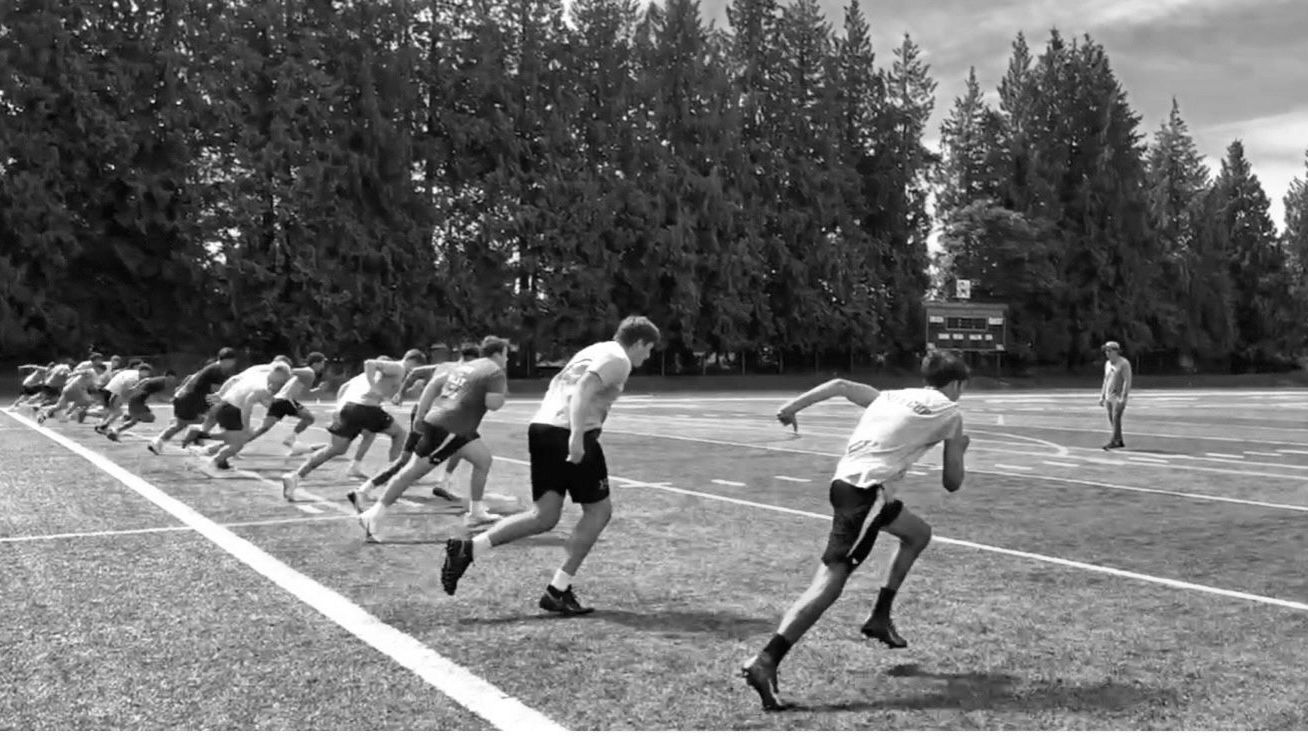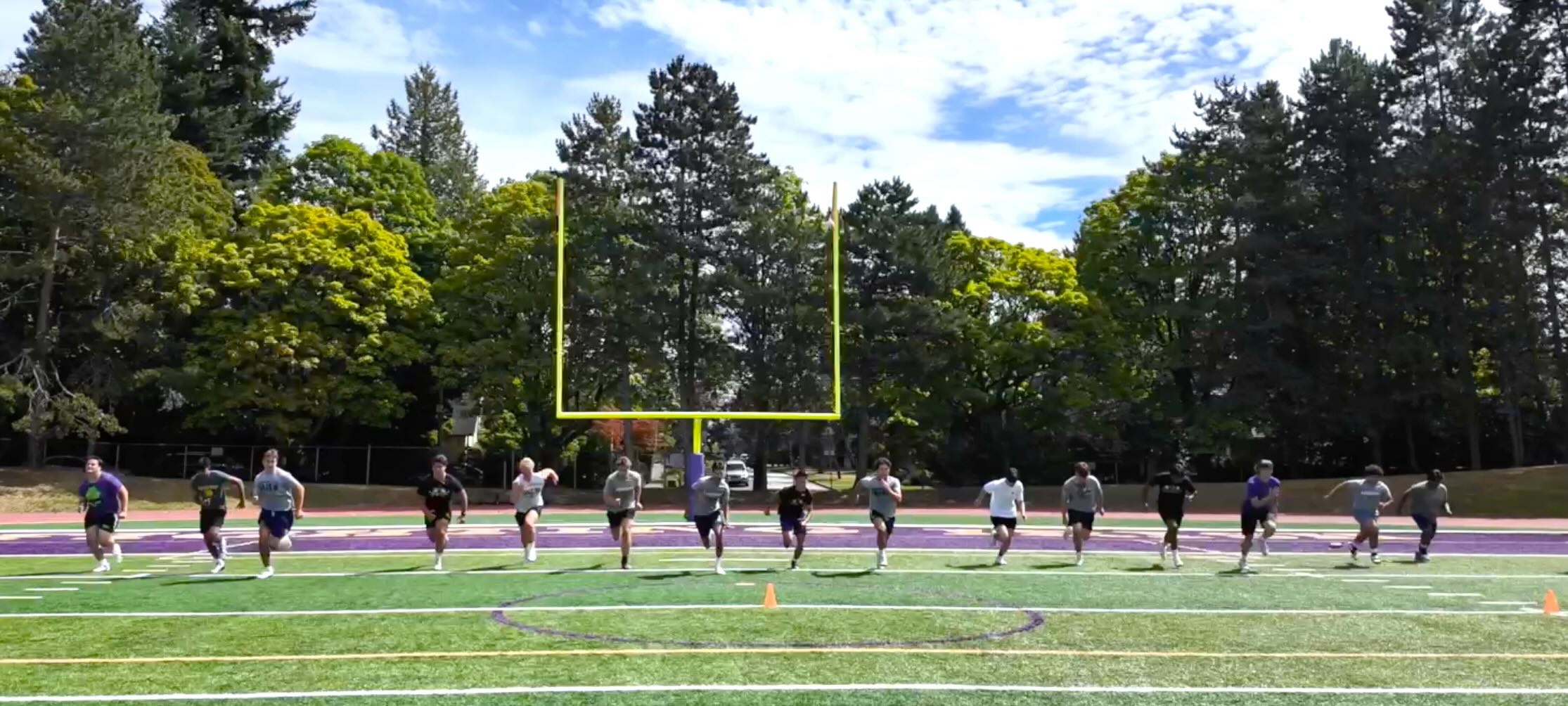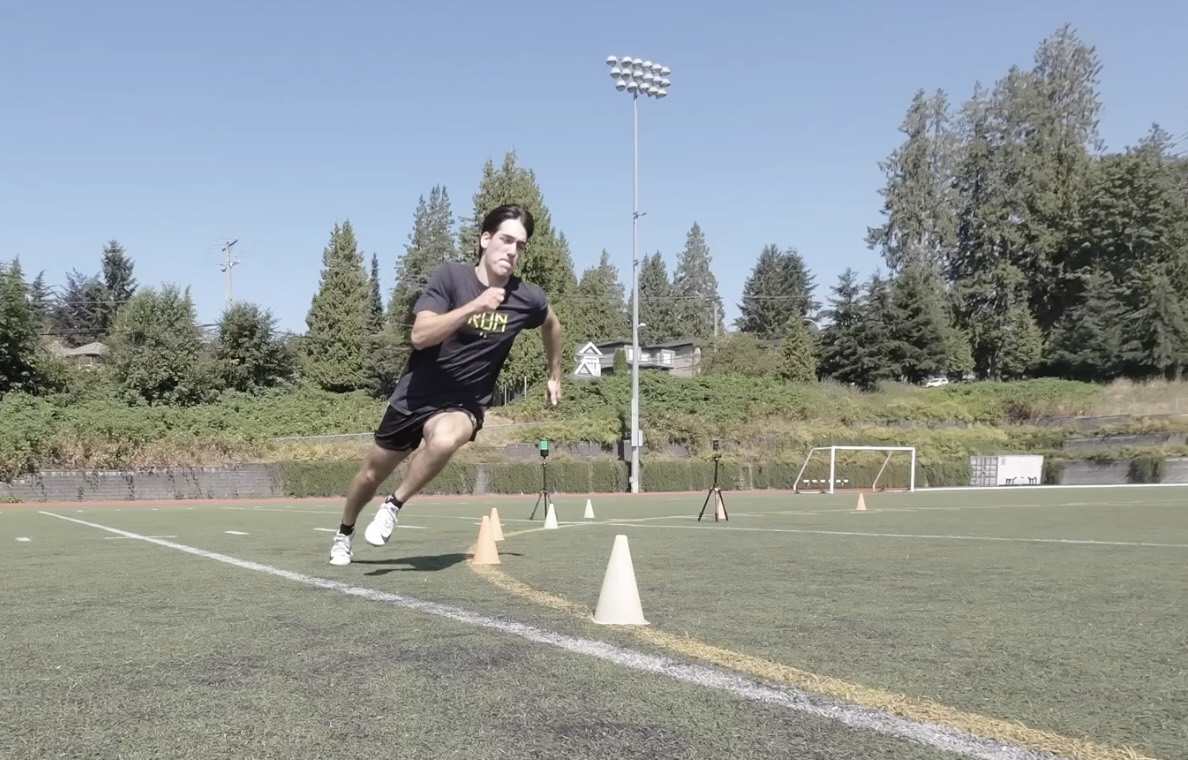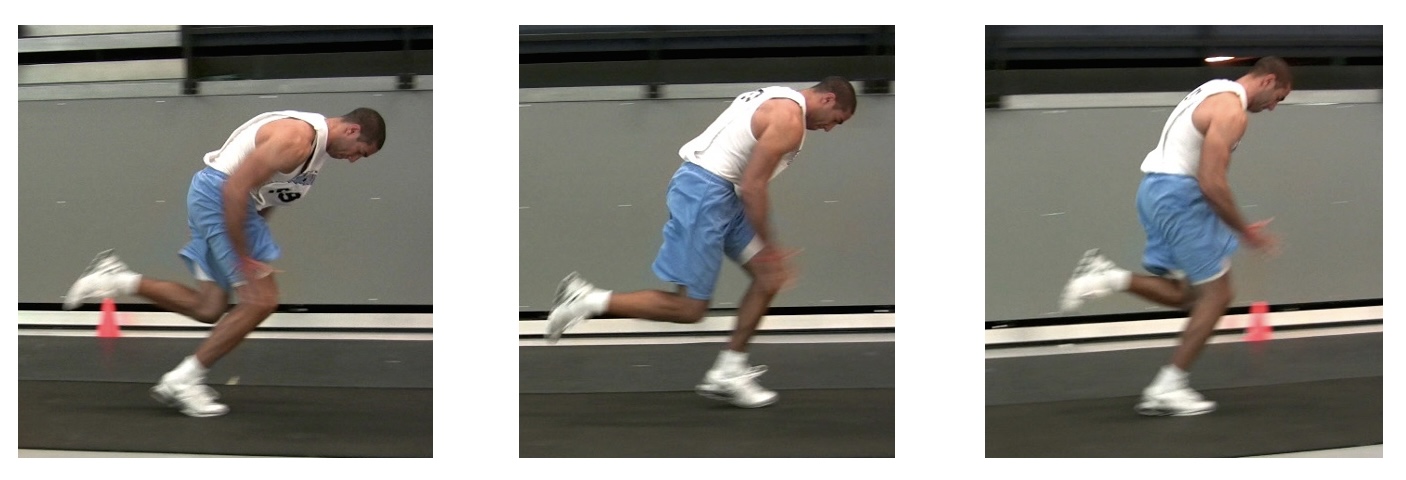The 10x10 Repeat Sprint Protocol: The Method Behind the Monotony

Derek M. Hansen - November / December 2025
Introduction
At a time when the best defence against complexity seems to involve some sort of technological fix, I am constantly searching for simpler ways to solve problems. It can be argued that compared to 30 years ago, life is much easier to navigate. We do not need to know how to read paper maps prior to a vacation or develop a sense of direction. We have GPS satellite navigation technology in our cars, phones, watches and smart glasses. Most evaluations by your physician can involve a simple collection of blood and urine – and possibly a swipe of stool – to determine your health status without having to submit to a digital rectal exam or colonoscopy, as exuberant an experience those manual tests can be. And, writing an article or email can be expedited and improved through the use of Artificial Intelligence (AI), even though your output may seem a little generic and sterile.
As I get older, digital solutions seem boring and predictable, and sometimes unreliable. I am constantly drawn to proven analog options, whether it is film photography, vinyl records, acoustic instruments, internal combustion engines or taking notes with a ballpoint pen and paper note pad. While it may seem old-school, this approach can yield consistent, meaningful results. All of these solutions also come with a feeling or sensation that can help guide or accompany intuition and instinct. So, what does this have to do with training and rehabilitation?
It is always a good practice to go back and re-examine methods and tools used by those who preceded you in your industry. How far back do you need to go? In my case, I have always been influenced by a lot of things that happened in the 1970s: Music and movies for sure, but maybe not fashion and psychedelics. Thus, when it comes to exercise and training methods, there is a lot of good stuff to be evaluated from this era. The 10x10 protocol is one of those things. Although it may been formulated decades earlier, it really started to take hold with Canadian coaches in the 1970s thanks to one man.
Background
My recently launched 10x10 Virtual Master Course takes you through a journey of discovery when it comes to the 10x10 protocol. While I have spent the better part of three decades examining all aspects of the protocol – evolving from return-to-play, to athlete conditioning to sprint density accumulation – the protocol was espoused as a simple means of maintaining both preparedness and readiness during periods of injury and recuperation. A number of Canadian track coaches were heavily influenced by the teachings of Polish sprint coach – Gerard Mach – who understood the value of maintaining fitness after an injury was incurred. These coaches – including Dr. Douglas Clement and Charlie Francis – understood that short acceleration distances were both productive and protective in the case of dealing with hamstring injuries. The limited exposure to high forces during manageable hamstring eccentric lengthening was a feature of short distance accelerations, while at the same time promoting movement, blood circulation, strength development and athlete confidence. Coaches during this time did not have access to high tech imaging through MRI or ultrasound, and were left to fend for themselves using basic biomechanics and common sense.

Figure 1: Charlie Francis (top), Gerard Mach (right) and Dr. Douglas Clement (bottom)
The main thrust of the protocol was to return athletes back to training as soon as possible, replacing lost training with a reasonable equivalent. In the late 1950s, researchers had completed a number of studies that explored the negative impacts of inactivity, replacing exercise in healthy participants with bed rest. The results were shocking, with subjects losing muscle mass, bone density, strength, neurological efficiency and circulatory abilities. Hence, returning high level competitive athletes back to running as soon as possible after a muscle strain was imperative for both their health and performance abilities.
Short segments of acceleration work proved to be very effective at maintaining fitness and muscle strength, while also incorporating the skills required for running and not creating further hamstring tissue damage following a strain. If an athlete was typically running a total of 600-800 meters per training session over 100m and 200m repetition distances, this work could be subdivided into 10 meter segments over 10 repetitions to cover the same daily volumes. Athlete preparedness would be preserved at the very least and once the rehabilitation period was completed, jumping back into regular training and competition was relatively seamless.

My own development as an athlete and coach was influenced by exposure to the 10x10 protocol in the early 1980s, and later on through contact and discussion as a coach with these brilliant founding mentors. The general concept of introducing accelerations early in a return-to-play process was initially counter-intuitive, but then made perfect sense in a practical setting. I had seen other athletes rely on rest and passive therapies, only to re-injure again and again in their attempts to return to training and competition. There was something very powerful and persuasive about this protocol that I had to investigate further.
Evolution
Once you find something that works, you just put your head down and keep pushing in the same direction until something doesn’t work. If you are a boxer and opponents cannot seem to defend your powerful left hook, you keep throwing that punch and knocking people out. If you are an NFL offensive coordinator and the other team’s defense allows your running back to get 10 yards on every hand-off, you keep giving him the ball. That’s how I proceeded for years. An athlete has a hamstring strain and you simply implement progressively more intensive accelerations on consecutive days. Easy does it. But, I soon discovered some other happy accidents when implementing the 10x10 protocol for hamstring rehabilitation.
I noticed that athletes performed much better in competition after going through the return-to-play protocol. If we took two weeks to rehabilitate a Grade 1 or 2 hamstring strain, it would involve at least 10 days of repeat sprints. On average we would complete 4 sets of 10x10 or 40 repetitions of short sprints almost every single day of the week. Over 10 sessions, that would equal roughly 400 repetitions of relatively intense 10 meter accelerations, or 4,000 meters (4 km) of sprints. Meanwhile, their teammates would be participating in practice sessions that involved low speed running, walking and even long durations of standing. There was no way that these athletes would achieve 40 near-maximal sprints in one practice session, especially at the density of work that we were programming. The difference was exceptionally apparent once my athlete would return to practice and games. The athlete was better prepared and sharper than his uninjured teammates. Hence, we were ahead of the game if we continued to rely on the 10x10 for a portion of their physical preparation.
It only made sense – over 20 years ago – that I would begin to explore the value of the 10x10 protocol for basic sprint training and athlete conditioning. It started slowly, with me dropping in modified versions of the 10x10 protocol in a general preparatory phase following regular sprint training sessions – almost as a bit of an experiment. I wasn’t sure I wanted to go “All In” with the protocol just yet. I was also concerned that some athletes might perceive use of the protocol as a punitive measure like many of the conditioning protocols they had previously endured with overzealous sport coaches. Thus, there needed to be a warming-up period for the implementation of the protocol.
The qualities that I truly appreciate about the protocol for the General Physical Preparation (GPP) period is that it kills two birds (or more) with one stone. Firstly, it allows for the progressive integration of acceleration work in high volumes, but also keeps the overall intensity of runs sub-maximal with limited recovery breaks. The high number and density of repetitions also allows for many attempts to refine technique and improve posture. Technical improvements are easier to achieve in sub-maximal conditions and the subsequent repetitions ensure that the athlete has time to integrate the new technique into their regular movement vocabulary.

Figure 2: Timed 10x10 Protocol on a Rubberized Track Surface
Secondly, the protocol incorporates a sizeable volume of activity in a short period of time at a relatively high intensity, developing general fitness qualities such as aerobic endurance, whole body strength and athlete power. The density of work creates a significant – but general – supercompensation effect that helps all other training components including speed, strength and endurance. There is also a mental focus component that can be developed with modern athletes because of the sheer boredom experienced doing 40 to 60 short accelerations in a session with no fanfare or hype involved: Only very specific technical and physiological goals. This focus can carry over into the competitive environment.

Key Implementation Requirements
The primary attraction of 10x10 protocol – outside of its extreme efficacy – is the fact that you do not need much in the way of equipment. At minimum, you need enough linear space on a consistent, stable surface to allow for both safe acceleration and safe deceleration. From an equipment point of view, having a few marker cones to delineate start and finish points can easily designate your running area. As illustrated in Figure 3, 25 meters or yards of linear space will allow you to accelerate for 10 m/yds and decelerate for 10 m/yds with a few meters at the end for turnaround space. The setup can be as simple as this, allowing you to complete the runs safely and effectively, whether for rehabilitation or performance. Width requirements may only be 1.2 meters per direction, but will also depend on the number of athletes you are running simultaneously and how comfortable they are running in close proximity to each other. Ideally, you would have adequate width to avoid any incidental contact or collisions should someone fall or deviate outside their lane.

Figure 3: Minimum Linear Distance Requirements for a 10x10 Protocol
If you have some extra linear space, providing more deceleration distance for faster athletes is a convenient modification. In the case of Figure 4, we have provided a deceleration distance of 15 m/yds to limit eccentric stress on the shins and quads for athletes. A total linear space allotment of 30 m/yds is all that is required. I have personally found that using a 10 m/yd acceleration distance with a 15 m/yd deceleration distance provides the best scenario for acceleration development and conditioning, at least for the initial introduction of the protocol to an athlete population. Faster athletes will have enough deceleration distance to comfortably finish their run and then step into the adjacent lane to sprint back and continue the set.

Figure 4: Additional Deceleration Distance Requirements for a 10x10 Protocol
As mentioned previously, width requirements will vary by space availability and configuration of athlete groups. For an indoor facility with limited space, athletes can be run in a queued format, following each other around a circuit. I have been able to run as many as 10-12 athletes in this format in a relatively small indoor space, providing reasonable gaps between athlete repetitions. This works well for conditioning scenarios, where there is not a need to implement precise segment timing and athletes can run at their own pace. Figure 5a shows an indoor conditioning scenario with 12 athletes running simultaneously. We ensured that there was adequate separation from the opposing groups to minimize the risk of collision or interference. The separate of running lanes also allows for a smoother change of direction as athletes take a gradual curved path for their return sprint.

Figure 5a: 10x10 Width Requirements for Group Indoor Workouts
In the case of running the 10x10 protocol in outdoor field environments, have access to a full football or soccer field makes things a lot easier for athlete management. Having athletes run abreast of each other allows you to monitor their relative acceleration abilities in larger groups. We do advise teams to use video to record sessions so that technique can be screened between training sessions, with feedback provided at subsequent sessions. Figure 5b provides a look at a full field width arrangement, using the football field yard lines to determine sprint distances and deceleration zones. In some cases, smaller groups of athletes can occupy different quadrants of the field to separate by position group, age, size or sprinting abilities.

Figure 5b: 10x10 Width Requirements for Outdoor Field Workouts
Monitoring and Evaluating Performances
One of the easiest ways to monitor athlete output in the 10x10 protocol is to simply track the time required to complete one set of 10 repetitions. A simple stopwatch can easily track these metrics with large groups, while also keeping time on the recovery periods between sets. Figure 6 identifies a spectrum of set completion times and corresponding single rep completion times. Shifting work-to-rest in favor of work creates a greater conditioning response, while providing more times between repetitions allows for greater focus and quality for individual repetitions in an effort to build acceleration abilities. Because rehabilitation work is predominantly sub-maximal efforts with an emphasis on athlete and coach awareness, it sits in the middle ground between conditioning and speed development. The density of work is high enough to challenge the athlete and build work capacity, while at the same time keeping running velocities at a lower level to mitigate risk.

Figure 6: 10x10 Set Time-to-Completion Spectrum
Although the time to complete a 10 m/yd repetition is typically just under two seconds, energy is still expended on deceleration requirements and getting ready for the next repetition. For higher intensity efforts, more time is taken getting ready for subsequent repetitions, allowing for extended athlete recovery. In a speed-oriented workout, taking as long as 20 seconds per rep may be indicated. Figure 7 illustrates a typical distribution of work-to-rest for a 10x10 protocol completed in just under 60 seconds with 6 seconds dedicated to each repetition. With 1.5 to 2 seconds occupied by the actual acceleration, the athlete has another 4 to 4.5 seconds to decelerate and be ready for the next repetition. Coaches can typically call out a countdown sequence to initiate the next repetition or use a whistle to signal the next start. The goal would be to move through a combination of these “Time to Completion” scenarios throughout an extended training program to reap the benefits of all aspects of the energy system spectrum.

Figure 7: 10x10 Individual Rep Time Allotments – 6 Seconds Per Rep
If you have access to timing equipment or GPS monitoring technology, more specific data on performance can be captured during the 10x10 protocol. Electronic timing gates can provide very accurate sprint times for the 10 m/yd distances to determine repeat acceleration performance over multiple repetitions and sets. Figure 8 illustrates the placement of four sets of electronic timing gates for both directions of the 10x10 protocol, allowing for optimal deceleration zones and clear start and finish points. Different configurations of timing gates can be used depending on the brand and model of gates available. If only two pairs of gates are available, times may be recorded for only one direction of the repetitions, for a total of five of the 10 runs.

Figure 8: 10x10 Setup with Four Sets of Electronic Timing Gates
GPS technology can be used to monitor large groups of athletes at once capturing velocity and acceleration data, as well as deceleration rates. Thresholds can be established for athlete velocities to ensure that the intensities of each repetition remain high throughout a workout. Figure 9 provides a view of the type of output captured and processed using GPS monitoring and the associated software platform. These types of dashboards can allow for the regular collection of workout data that can be tracked over months and years. While it is important to identify improvements in velocity over time, it is also recommended to monitor fatigue – using either GPS or timing gates – to determine athlete preparedness and identify optimal volumes and training progressions for a given set of athletes. For example, with athletes that are beginning a preparatory phase, it may be determined that performance drops off significantly after five consecutive 10 m/yd sprints, with fatigue also leading to biomechanical errors. In this case, it may be prudent to limit introductory sets to five repetitions until general fitness is improved.

Figure 9: 10x10 GPS Data Output (Courtesy of Steve Gisselman, VX Sport)
"A common point that people will ask is whether Computer Vision can extract even more kinematic or estimated kinetic data. Early products are showing promise, but even if the future is markerless cameras, focus on getting the work done properly, as that is half the battle. In a few years, this article will age well as many of the concepts are timeless, and will reward the practitioner who has plans on managing the training technique and loading protocols. Much of the current research is pointing out the importance of personalized programming for improving outcomes in injury prevention, and hopefully, the technology companies will deliver a convenient solution." Carl Valle @spikesonly
Variations Within the 10x10 Protocol
Although the 10x10 protocol is a very simple approach to using linear accelerations as a means of improving general fitness, acceleration abilities and overall strength and power qualities, variations can be introduced to enhance other useable qualities in competitive environments. Some coaches will incorporate curved runs as part of the acceleration protocol to prepare athletes for the non-linear nature of competitive sports. Curved runs present addition skill requirements and stressors for the athlete as shown in Figure 10.

Figure 10: 10x10 Protocol with Curved Sprint Segments
Curved runs in both directions have the ability to strengthen muscles that control lateral stability and support, including supporting structures in the feet, ankles, knees, hips and core musculature. Performing periodic sprints in a curved fashion will help to acclimate the body to the stress incurred by these intense sprints. As with the regular linear versions of the 10x10 protocol, the density of work decreases that intensity of individual runs and allows for the stacking of numerous repetitions to develop both movement skill and soft-tissue integrity. It is advisable to limit the number of sets of curved runs introduced to athletes due to the cumulative stress placed on the body and the risk of overuse injuries.
The 10x10 protocol can also introduce greater deceleration requirements as athletes improve overall fitness and lower body strength. While a standard 10 m/yd acceleration zone combined with a 10m/yd deceleration zone can be quite demanding for most athletes, gradually decreasing the deceleration zone to 5 m/yds can help to build eccentric strength qualities for efficient braking. Figure 11 illustrates a configuration that incorporates shorter deceleration zones of 5 m/yds for each repetition. Athletes may be progressed from 10 m/yd decelerations to 7 m/yd and then 5 m/yd. In some cases, we have had very skilled athletes work to 3 m/yd deceleration zones, but were very careful to limit the volume of this configuration to two sets. As long as athletes have been following a proper progression of work, you should be able to make subtle adjustments over time to get them to reach their acceleration and deceleration goals.

Figure 11: 10x10 Protocol with Shortened Deceleration Zones
There are also sport-specific variations of the 10x10 protocol that we have introduced with different groups, particularly in the specific preparation phases of their training program. Common examples included dribbling a basketball or soccer ball through the 10x10 repetitions, or carrying a lacrosse or field hockey stick while completing the runs. We have also implemented different variations on the ice surface with our college and pro hockey player clients to develop both conditioning and acceleration qualities via the skating medium as shown in Figure 12.

Figure 12: 10x10 Protocol with an Ice Hockey Player
Return-to-Play and Rehabilitation Applications
As mentioned previously, the 10x10 protocol was developed out of necessity to maintain and build the physical abilities of running athletes who sustained a lower body soft-tissue injury, such as a hamstring strain. Doing something is always better than doing nothing and structuring the work in a common-sense manner yielded very positive and timely results. When combined with some preparatory running drills – often used to evaluate the extent of the injury – the 10x10 protocol can safely return athletes to running in an efficient manner.
Figure 13 illustrates why short acceleration runs allow an athlete to strengthen the whole body while minimizing forceful eccentric lengthening of the hamstring. In short accelerations, the foot hits the ground while the knee is still in significant flexion, limiting stretch on the hamstring muscles. A 10 yard or 10 meter acceleration is typically six to seven steps and allows the athlete to maintain this posture during the entire effort. There is still some load placed on the hamstring in short accelerations, but the load is managed in a way that yields strength gains without exacerbating the injury. The initial runs in a return-to-play process may be sub-maximal in nature to build athlete confidence and convince the mind and body that the approach is a safe one.

Figure 13: Short Acceleration Mechanics and Hamstring Rehabilitation
While the dominant protocol in the initial stages of the hamstring rehabilitation process is 10 x 10 meters/yards over multiple sets, there is a time when these segments are lengthened for two reasons. Firstly, the athlete will change posture over several steps – as illustrated in Figure 14 – and require greater lengthening of the hamstring as more steps are taken and posture becomes more upright, approaching maximal velocity running. A gradual lengthening of the sprint segments by 2.5 or 5 meters/yards allows for the measured introduction of these postural demands. Secondly, longer accelerations yield higher velocities. If a 10 m/yd acceleration allows an athlete to reach 70% of top velocity, a 15 m/yd acceleration can result in a speed at 80% of top velocity, and 20 m/yd yielding 90% of maximum velocity. Thus, a short-to-long based acceleration program allows for the precise progression of sprinting load from both a biomechanical basis and a central nervous system demand basis.

Figure 14: Changing Dynamics on Every Step Through Acceleration
As with the regular 10x10 protocol setup, a return-to-play practitioner need only to show up at the training venue with a series of cones, a stopwatch and a keen coaching eye. While intensity monitoring can be aided with the use of timing gates or GPS sensors, sometimes the simple approach yields the least anxiety on the part of the athlete. Figure 15 identifies cone placements for acceleration and deceleration zones, with increase being shown at 5 m/yd increments. These increments typically yield increases of velocity of as much as 10 percent. If you want to bring athletes along much more gradually, using 2.5 m/yd increments will lower those increases to roughly 5 percent.

Figure 15: Setting Up Short-to-Long RTP Sequences with Cone Placements
In a typical short-to-long hamstring rehabilitation process, you can expect to see the following relationship illustrated in Figure 16. In the initial stages of RTP, you will rely heavily on accumulating running volumes over 10 m/yds in sets of ten where the velocities are relatively low and the mechanics are less risky. As athletes build strength and confidence, moving out to 15 or 20 m/yds yields higher velocities that are still manageable, while at the same time allowing you to build relatively high session volumes. It is not uncommon to hit 500 to 700 m/yds of sprint volume in this second stage. In the final stage, working out to 30 or 40 m/yds will yield the highest velocities ranging from 90-97 percent of maximal recorded speeds, but will also require longer rest periods between repetitions and lower overall workout volumes of 200 to 300 m/yds (or 40% of maximal volumes). This progression returns an athlete back to regular training performances and provides a good indicator for both preparedness and readiness on the field or court of play.

Figure 16: Interplay Between Volume and Velocity in the Hamstring RTP Process
While the 10x10 protocol is a perfect approach to hamstring rehabilitation, I have found myself using the same structure for other injuries. Simple modifications can be made to fit the circumstances of the athlete, as illustrated in Figure 17. If an athlete has a hamstring injury or knee injury, I tend to keep them in an acceleration posture over a short distance. However, for hip flexor strains or injuries related to calf, foot or the Achilles tendon, I tend to maintain a more upright posture for the runs. In most cases, these upright runs will begin with an upright jog-in or high-knee drill for a short distance to build up speed for the main portion of the sprint. These postural changes tend to shift the demands on specific muscle groups to allow for a more gradual re-introduction to running. In all cases, there may be some degree of trial-and-error required to find the right posture and technique. Ongoing communication with the athlete is imperative to get a sense of what they are feeling and how they are perceiving the process. Ongoing video analysis can also help them view their body in space while being re-introduced to running.

Figure 17: Start Types for Various Injury RTP Processes
Opportunities to Learn More About the 10x10 Protocol
The beauty of the protocol is that you can apply it and shape it to fit your general or specific needs. If athletes are demonstrating poor physical fitness, you can use submaximal versions of the protocol to build work capacity in a very efficient manner. Athletes appear to display less disdain towards this approach to conditioning than I have seen with other methods. Conversely, if you want to improve acceleration mechanics and abilities, maximal efforts on 10 meter/yard sprints over multiple sets can improve repeat sprint abilities very efficiently. And, variations of the 10x10 protocol can fill in gaps, build overall injury resiliency and serve as an effective means of returning athletes to sport.
I have tried to provide a succinct overview of the 10x10 protocol in this article as I have learned and applied it over the last 35 years. With every year of using the protocol, I discover new wrinkles and nuances that allow me to be a better practitioner. As such, I have created a Virtual Master Course on the protocol that cover 14 hours of lectures and demonstrations so that no stone is unturned in your quest for knowledge on this technique. The virtual course is also eligible for 1.7 CEUs through the NSCA. In addition, I have also had the opportunity to work with researchers such as Ryan McLaughlin, who is in the final stages of completing his comprehensive PhD studies on the 10x10 protocol. Please follow Ryan on Instagram for more insights into his research. Requests for more information and questions can be directed to my email at [email protected].

We are also providing a special discount on the 10x10 Virtual Master Course to readers of this article of 15% off for a limited time until the end of 2025. Please find the discount link below to start your continuing education journey with the 10x10 protocol:
10x10 Virtual Master Course – 15% Blog Discount
https://www.sprintcoach.com/offers/3WdhJE6w?coupon_code=10X10BLOG

